Efficient User-Serving Scheme in the User-Centric Cell-Free Massive MIMO System
Abstract
:1. Introduction
- In order to keep the computational complexity and fronthaul requirements to a realistic level, conjugate beamforming (CB) is used for precoding, and the equal gain algorithm is used for power control [8,13]. Each AP performs channel estimation locally, and the channel model used in this paper is assumed to be flat fading [10,11]. In addition, all APs support users as the number of installed antennas.
- The proposed scheme is derived from the distribution of per-user throughput. It is shown that the majority of per-user throughput is obtained from only a few APs. Based on this observation, the unserved users can be served while existing user data rates are maintained. By applying the proposed scheme, it is possible to obtain an improved per-user throughput through the cumulative distribution function (CDF) for the worst 10% of users compared to the previous scheme in [20] with many users, and also to achieve an improved sum throughput and BER performance.
- In this paper, the sum rate performance simulation is conducted in several situations for comparison . For sensitivity analysis, the situation where perfect channel state information (CSI) or channel estimate is applied is compared, and a simulation is performed on the effect of the limitation on the number of pilot sequences.
2. Network Model and Spectral Efficiency
2.1. Uplink Pilot Transmission and Channel Estimation
2.2. Downlink Data Transmission
2.3. Uplink Data Transmission
3. Observation of Distribution for Per-User Throughput
4. Proposed Scheme and Power Control
4.1. Analysis of the Previous Scheme
- (a)
- There is no consideration for the occurrence of another unserved user.
- (b)
- It simply selects an AP that is close to the unserved user.
4.2. Proposed User Serving Scheme
| Algorithm 1 Proposed Unserved user Serving Scheme |
for i→K if STEP 1: Select candidate APs with high channel gain from user i. (If there is a user served only by a specific AP among users served by the APs in , the corresponding AP is excluded from group .) STEP 2: Define the set of users served by as . STEP 3: Extract the index set and channel gain of users in . STEP 4: Prioritize and list them in the order in which they are served by the largest number of APs among users in . STEP 5: Extract APs that provide the gains below the median in descending order for each user value from among the gains listed in descending order for each user. STEP 6: Connect the user i with the AP sets extracted in STEP 5 and execute the SINR cumulative sum (). while > The APs of the set extracted in STEP 5 are sequentially connected to the user i. end while end if end for |
4.3. Computational Complexity
4.4. Power Control and Pilot Assignment
5. Simulation Results
Simulation Analysis
- Imperfect CSI and orthogonal pilot per user.
- Imperfect CSI and only 60 orthogonal pilot sequences in the system.
- Perfect CSI and orthogonal pilot per user.
6. Conclusions
Author Contributions
Funding
Institutional Review Board Statement
Informed Consent Statement
Data Availability Statement
Conflicts of Interest
References
- Larsson, E.G.; Edfors, O.; Tufvesson, F.; Marzetta, T.L. Massive MIMO for next generation wireless systems. IEEE Commun. Mag. 2014, 52, 186–195. [Google Scholar] [CrossRef] [Green Version]
- Marzetta, T.L. Noncooperative Cellular Wireless with Unlimited Numbers of Base Station Antennas. IEEE Trans. Wirel. Commun. 2010, 9, 3590–3600. [Google Scholar] [CrossRef]
- Marzetta, T.L.; Ngo, H.Q. Fundamentals of Massive MIMO; Cambridge University Press: Cambridge, UK, 2016. [Google Scholar]
- Lee, Y.R.; Lee, W.S.; Jung, J.S.; Park, C.Y.; You, Y.H.; Song, H.K. Hybrid Beamforming With Reduced RF Chain Based on PZF and PD-NOMA in mmWave Massive MIMO Systems. IEEE Access 2021, 9, 60695–60703. [Google Scholar] [CrossRef]
- Jung, J.S.; Park, C.Y.; Oh, J.H.; Song, H.K. Intelligent Reflecting Surface for Spectral Efficiency Maximization in the Multi-User MISO Communication Systems. IEEE Access 2021, 9, 134695–134702. [Google Scholar] [CrossRef]
- Alsabah, M.; Naser, M.A.; Mahmmod, B.M.; Abdulhussain, S.H.; Eissa, M.R.; Al-Baidhani, A.; Noordin, N.K.; Sait, S.M.; Al-Utaibi, K.A.; Hashim, F. 6G Wireless Communications Networks: A Comprehensive Survey. IEEE Access 2021, 9, 148191–148243. [Google Scholar] [CrossRef]
- Akyildiz, I.F.; Kak, A.; Nie, S. 6G and Beyond: The Future of Wireless Communications Systems. IEEE Access 2020, 8, 133995–134030. [Google Scholar] [CrossRef]
- Ngo, H.Q.; Ashikhmin, A.; Yang, H.; Larsson, E.G.; Marzetta, T.L. Cell-Free Massive MIMO Versus Small Cells. IEEE Trans. Wirel. Commun. 2017, 16, 1834–1850. [Google Scholar] [CrossRef] [Green Version]
- Chen, Z.; Björnson, E. Channel Hardening and Favorable Propagation in Cell-Free Massive MIMO With Stochastic Geometry. IEEE Trans. Commun. 2018, 66, 5205–5219. [Google Scholar] [CrossRef] [Green Version]
- Ngo, H.Q.; Ashikhmin, A.; Yang, H.; Larsson, E.G.; Marzetta, T.L. Cell-Free Massive MIMO: Uniformly great service for everyone. In Proceedings of the 2015 IEEE 16th International Workshop on Signal Processing Advances in Wireless Communications (SPAWC), Stockholm, Sweden, 28 June–1 July 2015; pp. 201–205. [Google Scholar] [CrossRef] [Green Version]
- Mai, T.C.; Ngo, H.Q.; Duong, T.Q. Downlink Spectral Efficiency of Cell-Free Massive MIMO Systems With Multi-Antenna Users. IEEE Trans. Commun. 2020, 68, 4803–4815. [Google Scholar] [CrossRef]
- Interdonato, G.; Frenger, P.; Larsson, E.G. Scalability Aspects of Cell-Free Massive MIMO. In Proceedings of the ICC 2019–2019 IEEE International Conference on Communications (ICC), Shanghai, China, 20–24 May 2019; pp. 1–6. [Google Scholar] [CrossRef] [Green Version]
- Ngo, H.Q.; Tran, L.N.; Duong, T.Q.; Matthaiou, M.; Larsson, E.G. On the Total Energy Efficiency of Cell-Free Massive MIMO. IEEE Trans. Green Commun. Netw. 2018, 2, 25–39. [Google Scholar] [CrossRef] [Green Version]
- Masoumi, H.; Emadi, M.J. Performance Analysis of Cell-Free Massive MIMO System With Limited Fronthaul Capacity and Hardware Impairments. IEEE Trans. Wirel. Commun. 2020, 19, 1038–1053. [Google Scholar] [CrossRef]
- Bashar, M.; Cumanan, K.; Burr, A.G.; Ngo, H.Q.; Debbah, M. Cell-Free Massive MIMO with Limited Backhaul. In Proceedings of the 2018 IEEE International Conference on Communications (ICC), Kansas City, MO, USA, 20–24 May 2018; pp. 1–7. [Google Scholar] [CrossRef] [Green Version]
- Ammar, H.A.; Adve, R.; Shahbazpanahi, S.; Boudreau, G.; Srinivas, K.V. User-centric Cell-free Massive MIMO Networks: A Survey of Opportunities, Challenges and Solutions. IEEE Commun. Surv. Tutor. 2021, 22, 611–652. [Google Scholar] [CrossRef]
- Alonzo, M.; Buzzi, S.; Zappone, A.; D’Elia, C. Energy-Efficient Power Control in Cell-Free and User-Centric Massive MIMO at Millimeter Wave. IEEE Trans. Green Commun. Netw. 2019, 3, 651–663. [Google Scholar] [CrossRef] [Green Version]
- Björnson, E.; Sanguinetti, L. Scalable Cell-Free Massive MIMO Systems. IEEE Trans. Commun. 2020, 68, 4247–4261. [Google Scholar] [CrossRef] [Green Version]
- Demir, Ö.T.; Björnson, E.; Sanguinetti, L. Foundations of User-Centric Cell-Free Massive MIMO. arXiv 2021, arXiv:2108.02541. [Google Scholar]
- Li, Y.; Zhang, Y.; Yang, L. Power Control Strategy for User-Centric in Cell-Free Massive MIMO. In Proceedings of the 2019 IEEE International Conference on Consumer Electronics-Taiwan (ICCE-TW), Yilan, Taiwan, 20–22 May 2019; pp. 1–2. [Google Scholar] [CrossRef]
- Dao, H.T.; Kim, S. Effective Channel Gain-Based Access Point Selection in Cell-Free Massive MIMO Systems. IEEE Access 2020, 8, 108127–108132. [Google Scholar] [CrossRef]
- Buzzi, S.; D’Andrea, C. Cell-Free Massive MIMO: User-Centric Approach. IEEE Wirel. Commun. Lett. 2017, 6, 706–709. [Google Scholar] [CrossRef]
- Denis, J.; Assaad, M. Improving Cell-Free Massive MIMO Networks Performance: A User Scheduling Approach. IEEE Trans. Wirel. Commun. 2021, 20, 7360–7374. [Google Scholar] [CrossRef]
- Parida, P.; Dhillon, H.S.; Molisch, A.F. Downlink Performance Analysis of Cell-Free Massive MIMO with Finite Fronthaul Capacity. In Proceedings of the 2018 IEEE 88th Vehicular Technology Conference (VTC-Fall), Chicago, IL, USA, 27–30 August 2018; pp. 1–6. [Google Scholar] [CrossRef]
- Wang, R.; Shen, M.; He, Y.; Liu, X. Performance of Cell-Free Massive MIMO with Joint User Clustering and Access Point Selection. IEEE Access 2021, 9, 40860–40870. [Google Scholar] [CrossRef]

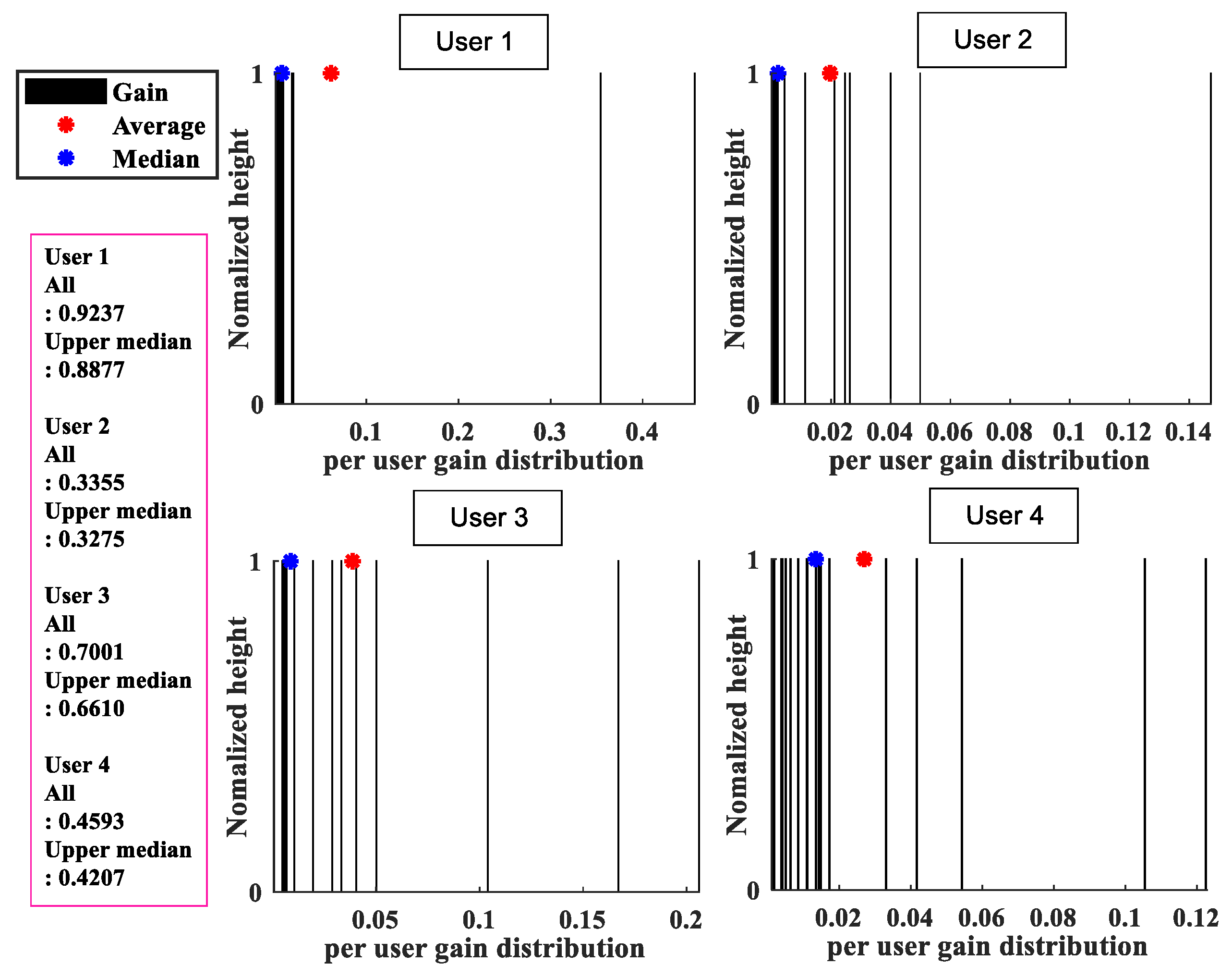
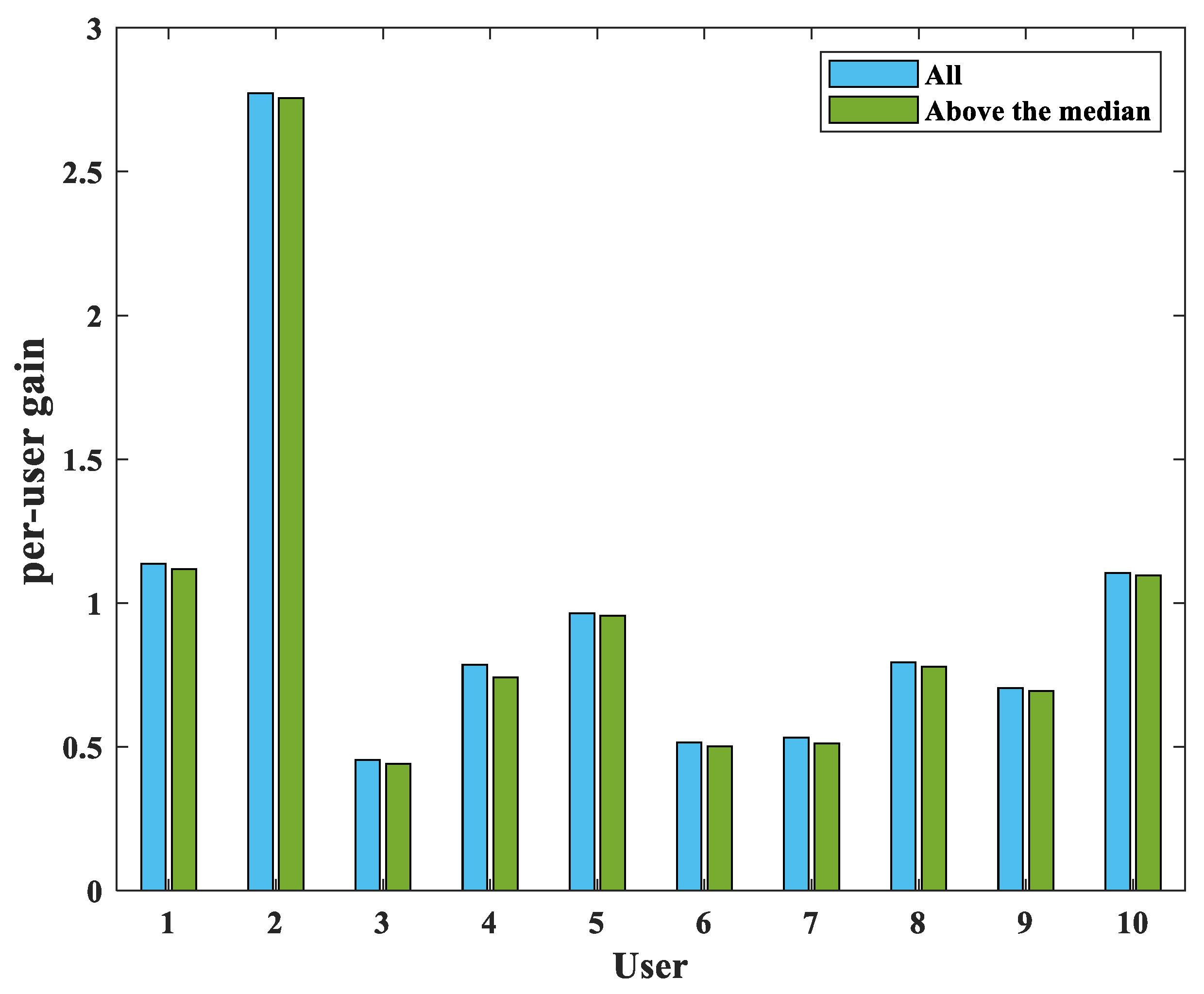
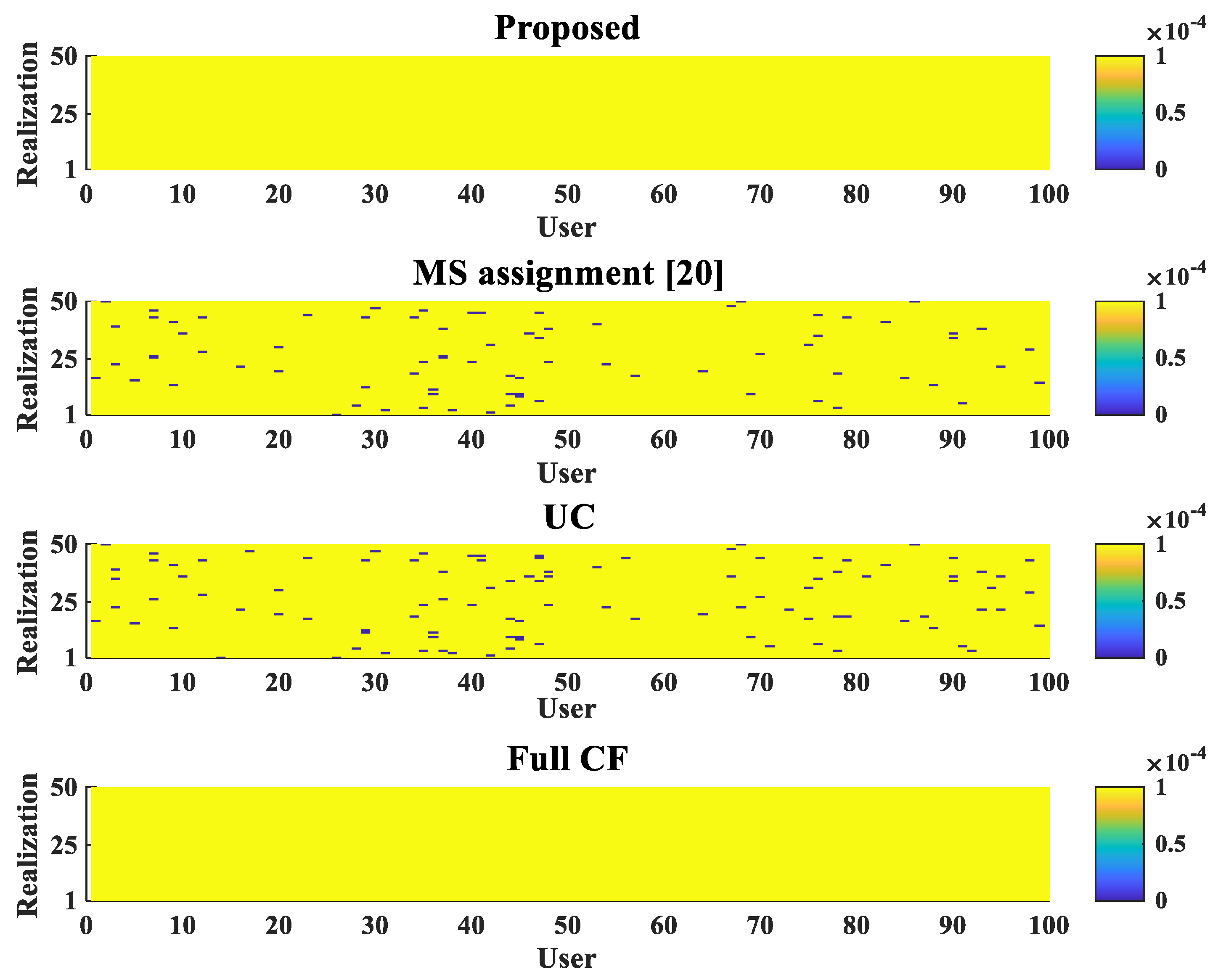
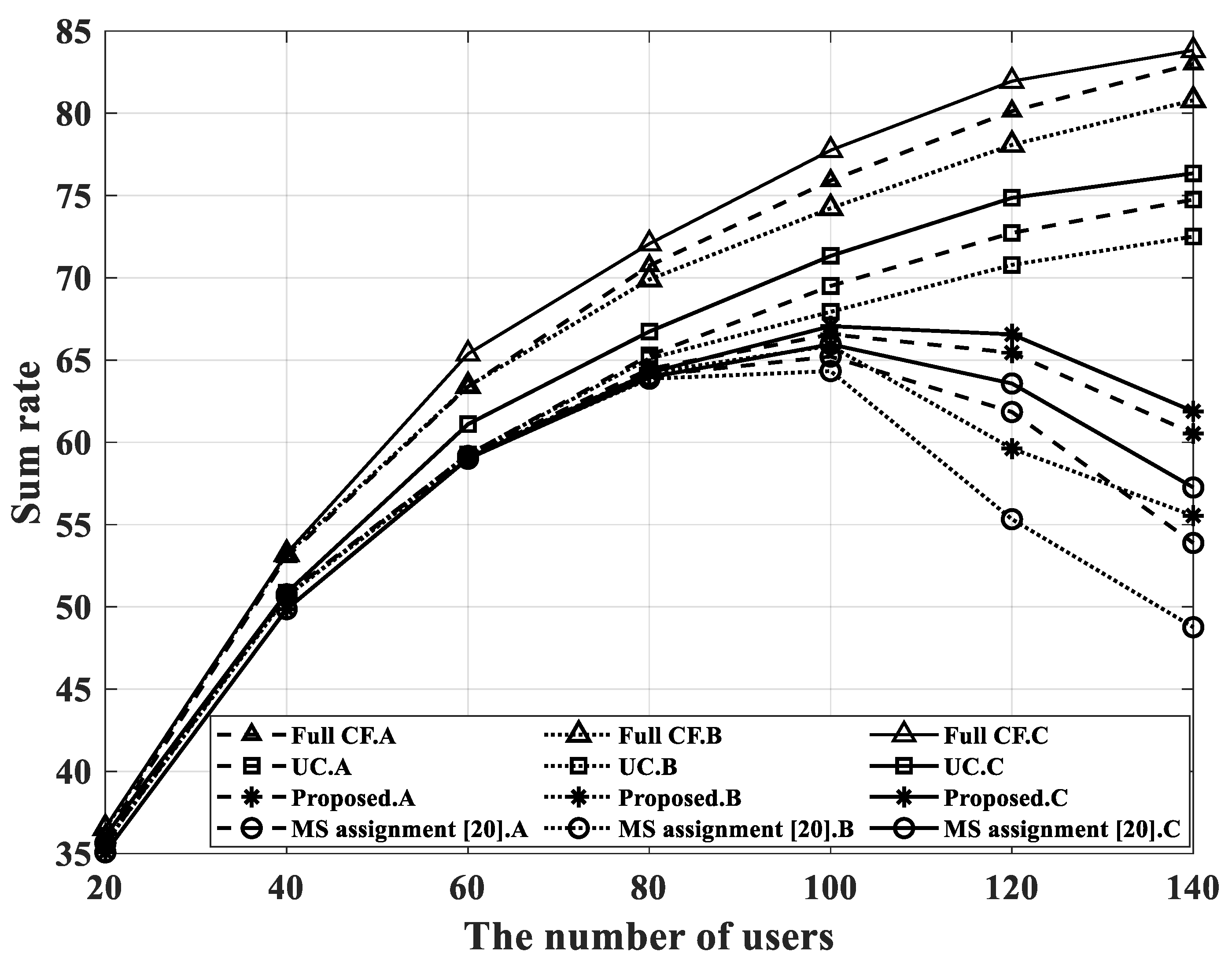
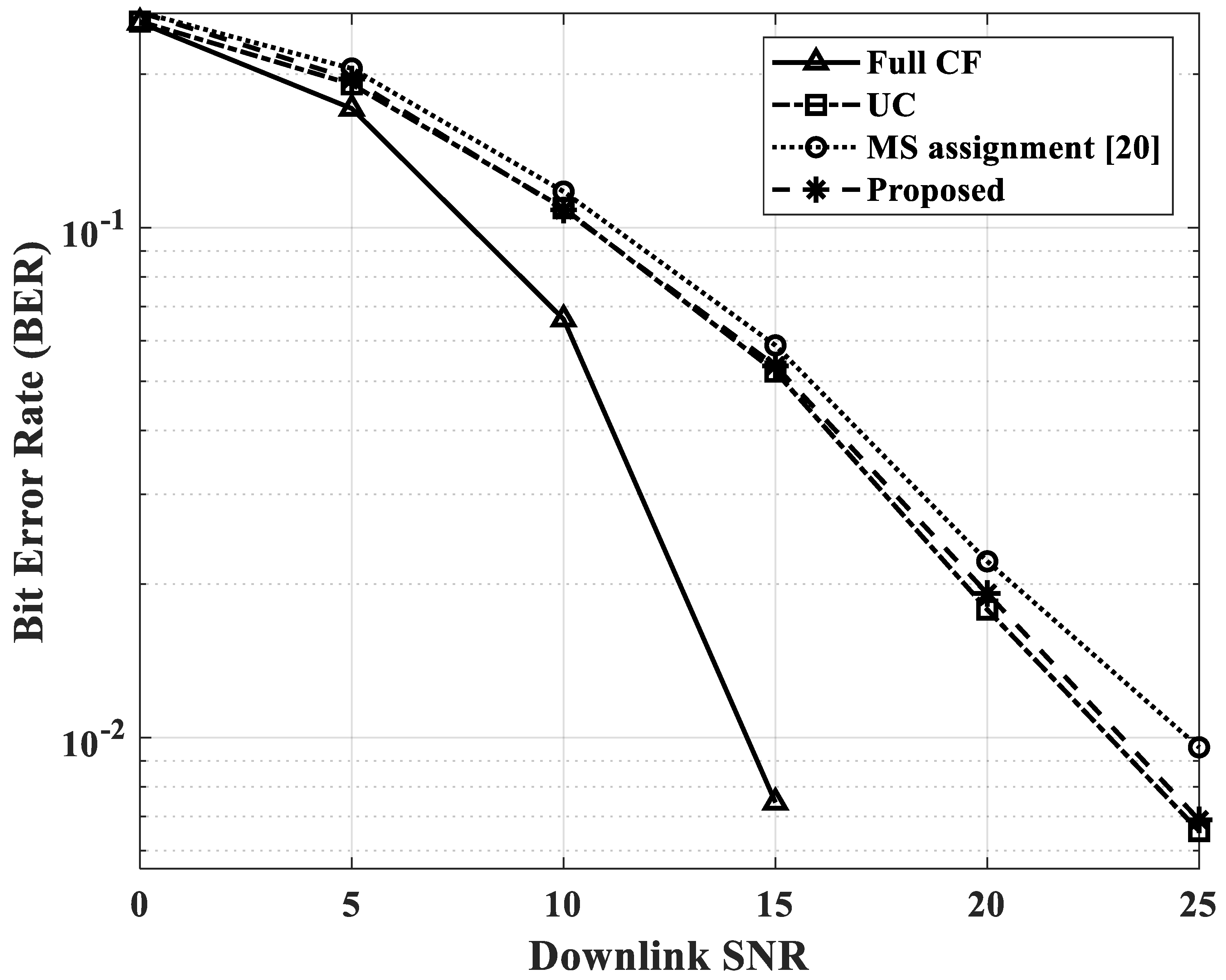

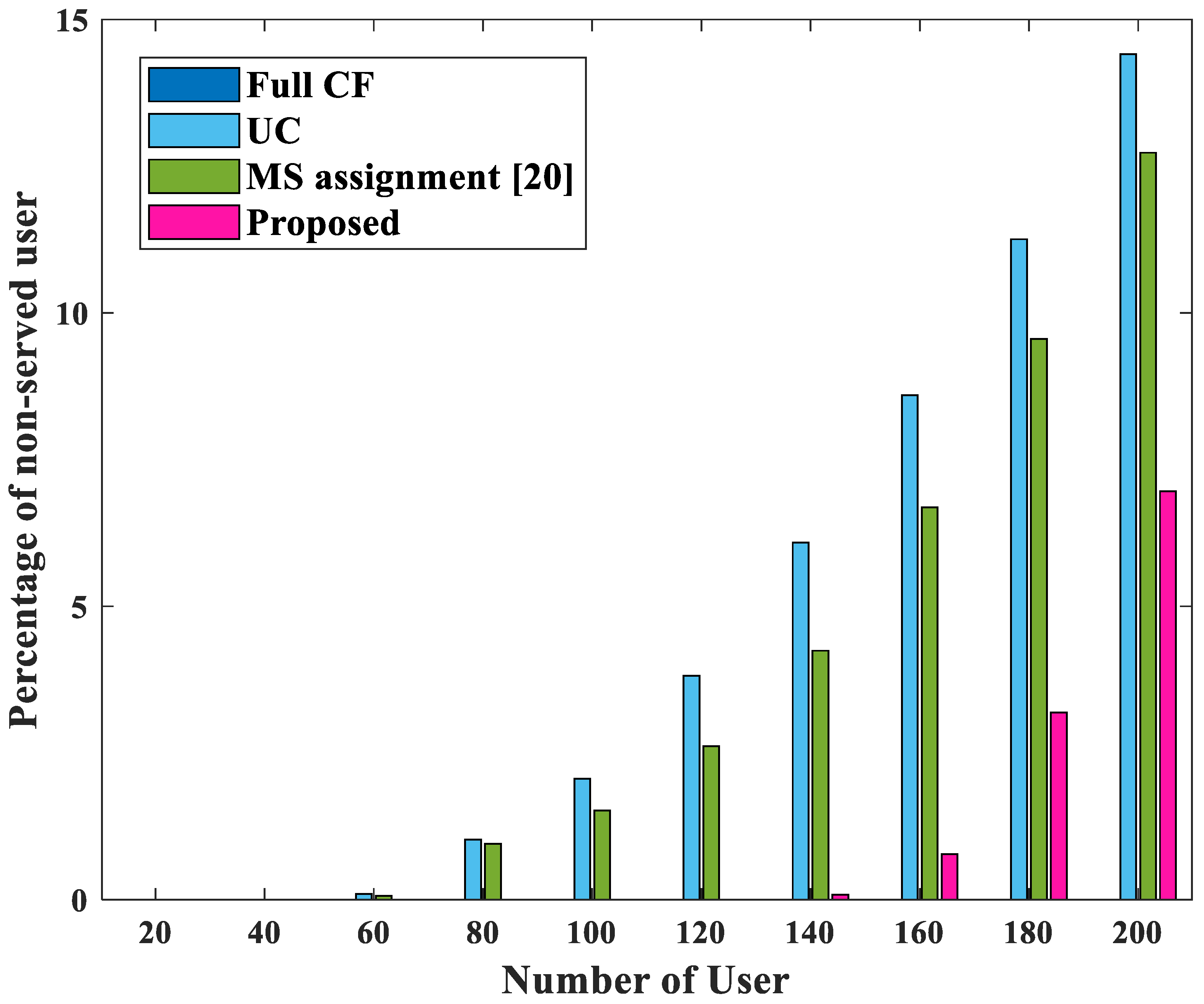
| Notation | Definition |
|---|---|
| Transpose and conjugate transpose | |
| Expectation value | |
| The complex conjugate operation | |
| Frobenius norms | |
| Circularly symmetric complex Gaussian distribution |
| Parameters | Value |
|---|---|
| Area | 1 × 1 k |
| Number of antennas for AP | 2 or 4 antennas |
| Number of antenna for users | Single antenna |
| User antenna height | 1.65 m |
| 100 mW, 200 mW | |
| Length of the pilot sequence | The number of users or 60 |
| Modulation | QPSK |
| Bandwidth | 20 MB |
| Noise figure | 9 dB |
Publisher’s Note: MDPI stays neutral with regard to jurisdictional claims in published maps and institutional affiliations. |
© 2022 by the authors. Licensee MDPI, Basel, Switzerland. This article is an open access article distributed under the terms and conditions of the Creative Commons Attribution (CC BY) license (https://creativecommons.org/licenses/by/4.0/).
Share and Cite
Oh, J.-H.; Shin, B.-S.; Kim, M.-A.; You, Y.-H.; Hwang, D.-D.; Song, H.-K. Efficient User-Serving Scheme in the User-Centric Cell-Free Massive MIMO System. Sensors 2022, 22, 3794. https://doi.org/10.3390/s22103794
Oh J-H, Shin B-S, Kim M-A, You Y-H, Hwang D-D, Song H-K. Efficient User-Serving Scheme in the User-Centric Cell-Free Massive MIMO System. Sensors. 2022; 22(10):3794. https://doi.org/10.3390/s22103794
Chicago/Turabian StyleOh, Ji-Hye, Beom-Sik Shin, Min-A Kim, Young-Hwan You, Duck-Dong Hwang, and Hyoung-Kyu Song. 2022. "Efficient User-Serving Scheme in the User-Centric Cell-Free Massive MIMO System" Sensors 22, no. 10: 3794. https://doi.org/10.3390/s22103794






